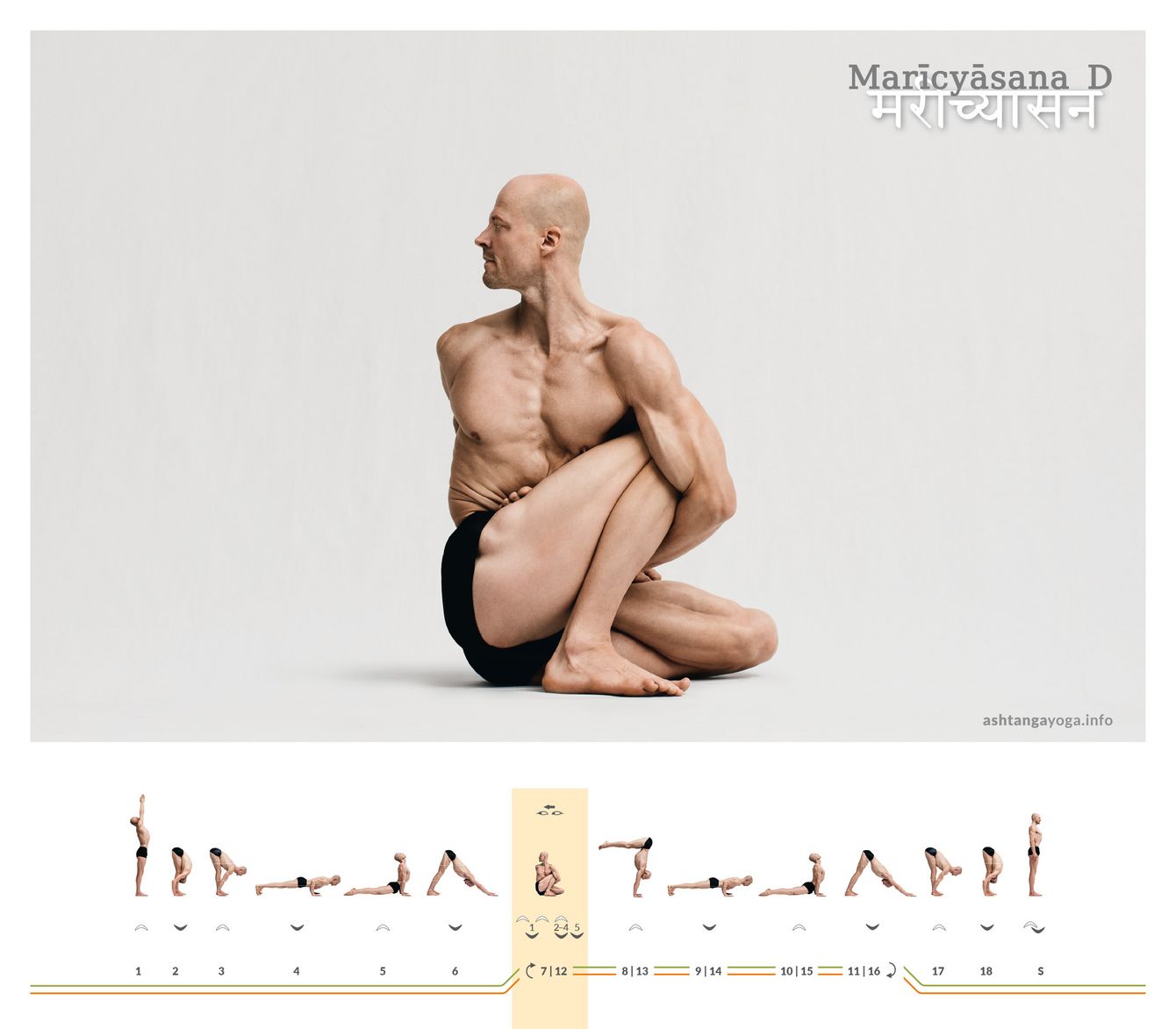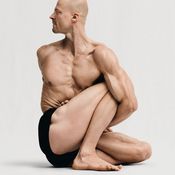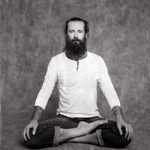

Directly from the Downward Facing Dog of the previous sequence.
Vinyāsa 7: Inhale, Exhale, Inhale:
Push off the Downward Facing Dog on an inhale and glide into a balance on your hands. Use the exhale to slowly lower yourself between your arms. Place your left foot into Lotus position and then bring your right foot as close to your hip as possible. Now, on an inhale, rotate over your right side, reach around your right leg with your left arm and grasp your right wrist. Keep your gaze pointed to the right until the fifth exhale.
Try this: Traditionally, this very complex posture is entered with a single movement. While the inhale and exhale are already largely spent on the jump and the lowering, only the end of the exhale and a single inhale remain for folding the legs and binding with the arms. Especially at the beginning, take the time for some extra breaths. Follow the advice from Marīcyāsana B and fold the Lotus as tightly as possible and tilt your pelvis to the left so that the left thigh remains in contact with the ground. Then, using the technique already presented in Marīcyāsana C, you can push your right thigh to the left with your right hand. This can allow you to reach forward with your left flank over the right thigh and bind your right wrist behind your back.
Vinyāsa 8 to 11:
Follow the familiar movement pattern back into Downward Facing Dog.
Vinyāsa 12 to 16:
Repeat the sequence on the other side of the body until you reach Downward Facing Dog again.
Immediately transition in the traditional count to the next posture and flow into the next movement.
Effect: If the femoral neck is pressing against the edge of the joint socket during the rotation, inflammation can occur (Impingement Syndrome). In Marīcyāsana D, the left foot is placed directly in this space on the right side. Thus, it creates a distance between the femoral neck and the edge of the socket. If you feel pressure on the socket in Marīcyāsana C, try Marīcyāsa D. However, if the Lotus position with the left foot is not possible for you, simply place a folded towel there. It has a similar effect and can relieve any pressure on the edge of the socket.
-

Benjamin Rossa
at 27.07.2022Hallo,
ich habe eine Frage zu Marichyasana D, hauptsächlich weil ich keinen Rat mehr weiß: Wenn man die Serie bis zu dieser Asana konsequent durchgeführt hat,
ist man in der Regel schon stark [...] Hallo,
ich habe eine Frage zu Marichyasana D, hauptsächlich weil ich keinen Rat mehr weiß: Wenn man die Serie bis zu dieser Asana konsequent durchgeführt hat,
ist man in der Regel schon stark verschwitzt. Entsprechend rutschig ist die Haut. Bei mir ist es nun so, dass ich zwar die Bindung beinahe herstellen kann, aber
nur bei ganz trockener bzw. eher klebriger Haut. Aber jeder kleine Schweißfilm führt unweigerlich zum Scheitern, weil mein Oberarm vom Knie wegen der aufeinandertreffenden Kräfte wegrutscht.
Was kann man dagegen tun, OHNE dabei ein Handtuch um das Bein zu wickeln oder sonstige Hilfsmittel zu verwenden? Ich habe mittlerweile genügend Videos von anderen Yogis gesehen, die ähnlich schweißgebadet wie ich diese Asana Haut auf Haut binden konnten, ohne abzurutschen.-
Hallo Benjamin,
wie schön von Dir zu lesen. Aus der Ferne ist das natürlich schwer zu sagen. Doch wenn Du, bevor Du Dich drehst, Dein Bein weit diagonal schiebst und Dich mit einer Vorbeuge über den [...] Hallo Benjamin,
wie schön von Dir zu lesen. Aus der Ferne ist das natürlich schwer zu sagen. Doch wenn Du, bevor Du Dich drehst, Dein Bein weit diagonal schiebst und Dich mit einer Vorbeuge über den Oberschenkel legst, dann bindest und dann erst aufrichtest. - hast Du meist eine gute Chance nicht abzurutschen.
Komme mich gerne mal zu einer Mysore Intensivwoche nach Ulm besuchen, wenn die Flexibilität sich entwickeln lässt und Deine Proportionen Dir nicht im Wege stehen, dann werden wir hier sicher einen Weg finden. Z.B. gleich im September:
https://de.ashtangayoga.info/220912-ulm-mysore-intensiv-woche-ronald/
Namaste und herzliche Grüße
Ronald
-


 Dr. Ronald Steiner
Dr. Ronald Steiner
 Richard Pilnick
Richard Pilnick


Messages and ratings